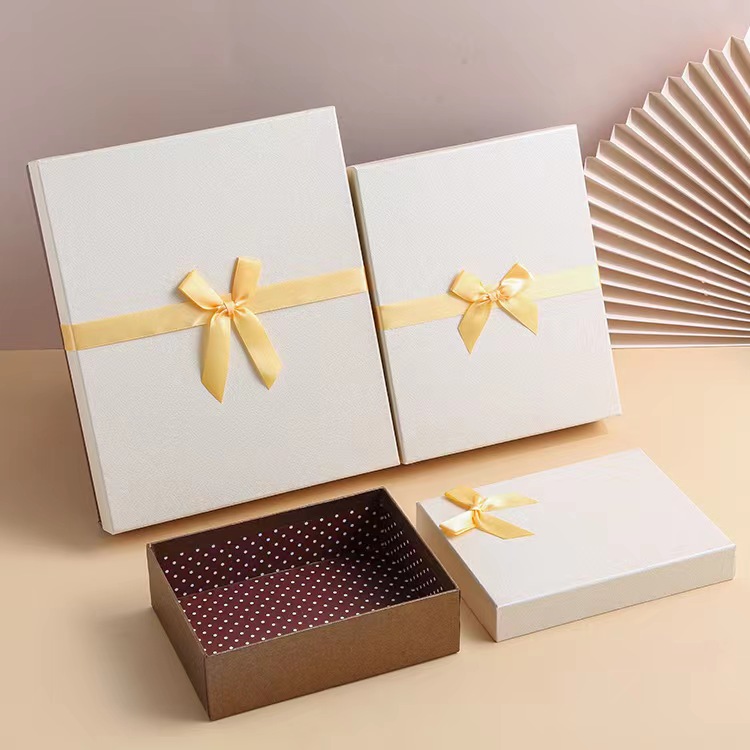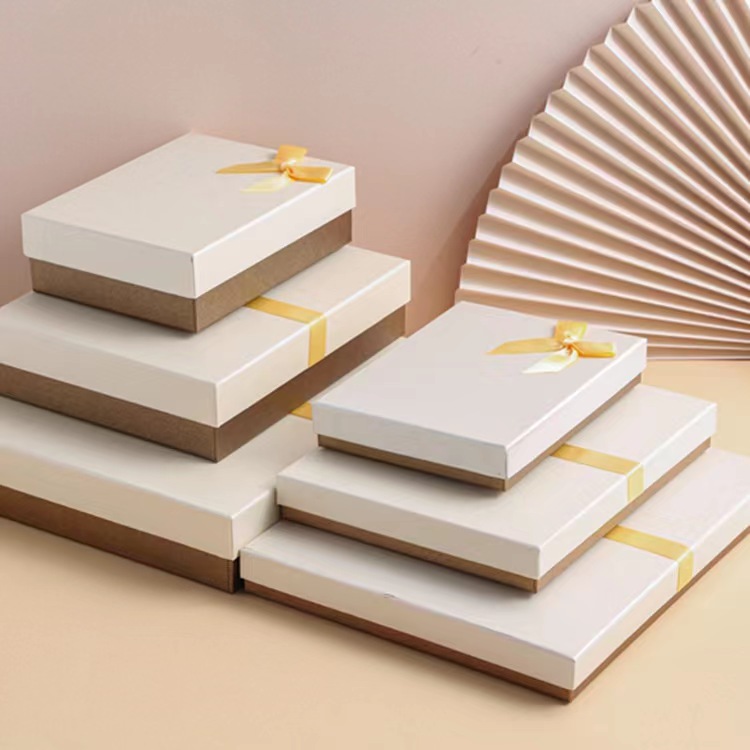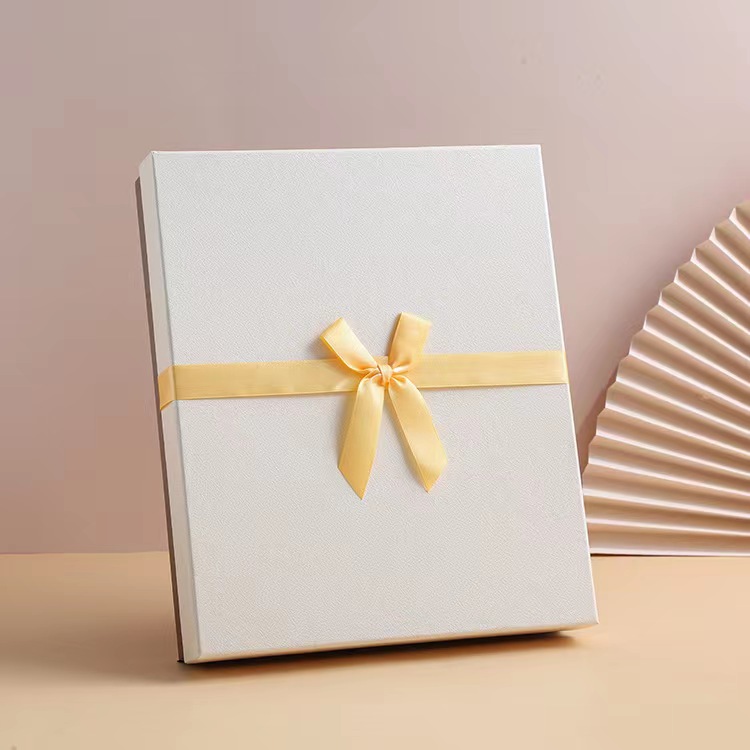Kazalo
Trda škatlasta embalaža je priljubljena izbira za določene izdelke zaradi svoje izjemne strukturne podpore in pridiha razkošja. Zaradi velike teže in visokih stroškov je pogosto sinonim za set-up boxe, vrhunsko embalažo ali vrhunske rešitve. V tem članku se bomo lotili obsežnega raziskovanja te embalaže, poglobili se bomo v njeno sestavo, prednosti in slabosti ter vam v razmislek predstavili nekaj pomembnih primerov.
 Kaj so toge škatle?
Kaj so toge škatle?
Toge škatle po meri predstavljajo robustno papirnato embalažo, sestavljeno iz iverne plošče visoke gostote, običajno debeline 2-3 mm, ki je okrašena s posebnim dekorativnim papirjem. Kot smo že omenili, so splošno znani kot set-up boxi ali vrhunska embalaža zaradi njihovega luksuznega videza in teksture, zaradi česar se odlično ujemajo z izdelki, kot so družabne igre, luksuzno blago, kot je nakit, ali darila.
Poleg tega te škatle po meri zagotavljajo vrhunsko izkušnjo razpakiranja, kar omogoča izboljšane priložnosti za vzpostavitev prepričljive pripovedi blagovne znamke. Ponujajo številne možnosti blagovne znamke s tehnikami tiska in dodelave, vključno z:
- Vroče žigosanje
- Vtiskovanje in debosiranje
- Različni premazi
- Okrasni elementi
Razumevanje razlike med prožnimi, valovitimi, zložljivimi kartoni in togimi škatlami po meri
Če ste raziskovali alternativne možnosti pakiranja za svoj izdelek, ste verjetno naleteli na izraze, kot so trda škatlasta embalaža, valovite škatle in zložljivi kartoni. Medtem ko je razlika med prožno in togo škatlasto embalažo razvidna iz njihovih imen, bo morda treba podrobneje pogledati valovite in zložljive kartone. Da bi zagotovili celovito razumevanje vsake možnosti in njihovih razlik, poglejmo kratek pregled.
Na področju embalaže izstopa trda škatlasta embalaža po robustni konstrukciji, trdni podpori in poudarjeni luksuzni privlačnosti. Te škatle so izdelane iz debele iverne plošče in so oblikovane tako, da ohranijo svojo obliko, v nasprotju s fleksibilno embalažo, ki se zlahka upogne in upogne.
Razlikovanje med drugimi možnostmi postane nekoliko bolj niansirano. Toge škatle se pogosto obravnavajo kot ločen razred, predvsem zaradi vrhunske predstavitve. Vendar postajajo vse bolj priljubljene alternative, vključno z zložljivimi kartonskimi škatlami in visokokakovostno valovito embalažo, ki slovijo po svoji stroškovni učinkovitosti in prilagodljivosti pri doseganju visokokakovostnega tiska in končne obdelave. Da bi jasneje razumeli razlike, se poglobimo v podrobnosti.
Zgornja tabela ponazarja, da si te možnosti sicer delijo podobnosti, vendar je izbira embalaže na koncu odvisna od vaših posebnih potreb in preferenc. Če želite raziskati dodatne alternative, preberite več o zložljivih kartonih ali valoviti embalaži. Če pa menite, da je ta možnost v skladu z vašimi zahtevami, nadaljujmo.
 Različne toge škatlaste embalaže po meri
Različne toge škatlaste embalaže po meri
Na voljo je v dveh različnih slogih: delni zaključek in popoln zaključek. Delna končna obdelava vključuje delno dokončan ovoj in iverno ploščo. Ovoj pokriva izključno zunanje površine škatle, notranja iverna plošča pa ostane izpostavljena. Pri tej možnosti se za prepogibanje in ovijanje uporabi en sam kos iverne plošče s perforiranimi gubami brez dodatnega zunanjega sloja, ki bi prikril kraft ali sivo iverno ploščo. Ta izbira je priljubljena zaradi svoje učinkovitosti pri proizvodnji, saj med gradnjo zahteva manj materialov.
Nasprotno pa popolna embalaža ne pušča izpostavljene iverne plošče; ovoj sega čez celotno škatlo. Ta metoda uporablja debelejšo iverno ploščo debeline 2-3 mm, notranja iverna plošča pa je razdeljena na ločene dele za vsako stran škatle. Lahko se vključi tudi laminacija, ki ponuja različne možnosti končne obdelave glede na vaše potrebe. Poleg tega popolna embalaža vključuje dodatno plast ovoja, običajno privzeto belo ali prilagojeno s tiskom. Torej, če povzamemo,
Delni zaključek:
- Ovije samo notranji rob škatle
- Notranji iveral je neobdelan in viden
- Uporablja en sam kos iverne plošče s perforiranimi gubami in pregibi
- Izbirna uporaba traku za pritrditev iverne plošče pred ovijanjem
- Iverna plošča je lahko enostransko bela ali kraft lakirana.
Popoln zaključek:
- Popolnoma zavit brez izpostavljenih ivernih plošč
- Notranja iverna plošča je razdeljena na kose za vsako stran škatle
- Ni potrebe po lepilnem traku pred zavijanjem
- Uporablja debelejše iverne (ali sive) plošče debeline 2-3 mm
- Zagotavlja laminirane možnosti z različnimi zaključki.
Kako so ustvarjene te toge škatle
Da bi poenostavili konstrukcijo te vrhunske toge škatlaste embalaže, smo postopek razdelili na štiri enostavne korake, ki veljajo za obe možnosti:
- Dimenzioniranje – Škatla se začne kot ploski karton, ki je na začetku razrezan in zarezan na pravilne mere.
- Zgibanje – Karton je nato prepognjen in varno pritrjen, da ustvari osnovo škatle.
- Tisk – Dizajn se natisne na ovoj in nato laminira. Po želji lahko vključite dodatne izboljšave. Ovoj je nato pritrjen na obliko vaše škatle.
- Ovijanje – Ovoj je tesno pritrjen, da pokrije vašo škatlo, in postopek je končan!
Priljubljeni slogi togih škatel
Raznovrsten High-End togo škatlasto embalažo ne ponuja le dveh različnih vrst, temveč tudi obilico stilskih izbir. Tukaj je nekaj priljubljenih možnosti:
Embalaža v obliki cevi ali cevi z zavitimi robovi: Ta valjasta embalaža je lahko teleskopska ali ima odprtino na vratu, zaradi česar je primerna za pijače, kozmetiko, dodatke in posode za prigrizke, kot so pločevinke Pringle.
Škatle z magnetnim zapiranjem: Te škatle so opremljene z dvema robustnima magnetoma, ki brez truda zapreta škatlo in dodata pridih razkošja nakitu in maloprodajnim izdelkom. Niso samo varni, ampak tudi zložljivi za priročno shranjevanje.
Škatle v slogu predalov: Kot že ime pove, se te škatle odpirajo kot predali in so znane tudi kot kovčki, diapozitivi ali škatlice za vžigalice.
Škatle v slogu knjig: Te škatle se odprejo kot knjiga s trdimi platnicami in dajejo občutek ustvarjalnosti in inovativnosti. Imajo lahko ravne ali zaobljene hrbtenice in lahko celo vključujejo magnetna zapirala za razkošen pridih.
Škatle na vratu: Te škatle z več plastmi, vključno z ločeno notranjo plastjo, na kateri se nasloni pokrov, zagotavljajo edinstveno izkušnjo razpakiranja in jih je mogoče prilagoditi tako, da ustrezajo estetiki vaše znamke.
Vstavki za dopolnitev vašega stila
Medtem ko so slogovne možnosti za togo škatlasto embalažo praktično neomejene, ko se odločite za želeno vrsto, je naslednja naloga izbira vložkov. Dodatni embalažni materiali, kot so vložki za škatle, so zelo priporočljivi za izboljšanje izkušnje razpakiranja.
Vložki za embalažo po meri so prilagojeni tako, da se natančno prilegajo vašemu izdelku, kar zagotavlja, da ostane varen, hkrati pa ponuja odlično zaščito pred udarci, tudi pred padci in grobim ravnanjem. Ti vložki so običajno na voljo v različnih materialih, vključno s kartonom, valovitim kartonom, oblikovano celulozo, peno in plastiko.
Prednosti in Slabosti toge škatlaste embalaže
Slabosti toge škatlaste embalaže
Zdaj, ko smo raziskali različne možnosti oblikovanja, se postavlja vprašanje: Zakaj se odločiti za to posebno rešitev embalaže? No, poleg svoje čvrste in zaščitne zgradbe, toga škatlasta embalaža ponuja izmuzljiv, razkošen in robusten videz ter otipljivo izkušnjo, ki zasenči večino drugih vrst embalaže.
Ta embalaža, ki jo pogosto dopolnjuje vložek po meri, ne le ščiti izdelke pred grobim ravnanjem, ampak tudi spodbuja ponovno uporabo. Kupci ponavadi obdržijo te škatle, namesto da bi jih zavrgli, potem ko izdelek razpakirajo. Ob upoštevanju teh prednosti postanejo toge embalažne škatle sestavni del, ki povečuje vaš izdelek in dodaja pomembno vrednost vaši blagovni znamki. Ko je vaš izdelek elegantno zavit v togo škatlo, ga kupci ne dojemajo več kot samostojen izdelek; namesto tega na embalažo in izdelek gledajo kot na koheziven sklop.
Povsem naravno je, da ljudje uživajo v darilih, toge darilne škatle pa trenutno predstavljajo vrhunec darilne embalaže. Vendar ima, kot vsaka možnost pakiranja, svoje pomanjkljivosti. Medtem ko je toga škatlasta embalaža izjemna za majhne do srednje velike izdelke, se njena odpornost zmanjša, ko se ukvarjate z zelo velikimi velikostmi. Večje škatle so bolj dovzetne za strgane robove zaradi večje obremenitve zunanjega ovojnega papirja. Zato je priporočljivo uporabiti debelejši papir z laminirano površino za večjo obstojnost večjih paketov.
Kljub temu je najpomembnejša pomanjkljivost vrhunskih togih škatel po meri njihova cena. Če smo odkriti, je izdelava ene od teh škatel dragocena.
Proizvodni proces za te vrhunske pakete se bistveno razlikuje od drugih stilov pakiranja. Podobno kot pri zavijanju daril, so toge škatle po meri natančno oblikovane tako, da se okoli trdnih desk ovije papir. Vsaka iverna plošča je posebej vezana, proizvodnja teh škatel pa vključuje podaljšan proces, ki lahko traja 1-2 tedna dlje kot alternativne metode pakiranja.
Trenutno večina proizvodnih procesov za to vrsto embalaže vključuje določeno stopnjo ročnega sestavljanja in natančnih pregledov kakovosti za odkrivanje napak in vzdrževanje standardov kakovosti. Posledica tega je strošek, ki je lahko do trikrat višji od stroškov zložljivih kartonov in valovite embalaže.
Medtem ko so povišani stroški zlahka opravičljivi za uveljavljene blagovne znamke, saj luksuzna embalaža krepi zaznano vrednost tako izdelka kot blagovne znamke, priznavamo, da se manjša podjetja pogosto soočajo s proračunskimi omejitvami. Zaradi tega vas vabimo, da raziščete naš drugi članek o ustvarjanju stroškovno učinkovite luksuzne embalaže, ki nudi vpogled v strategije varčevanja s stroški za toge škatle in alternativne možnosti.
